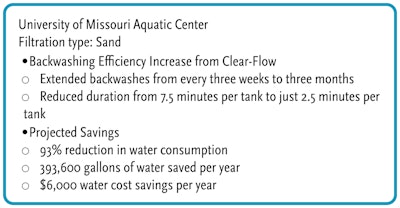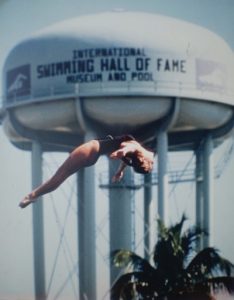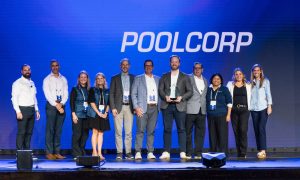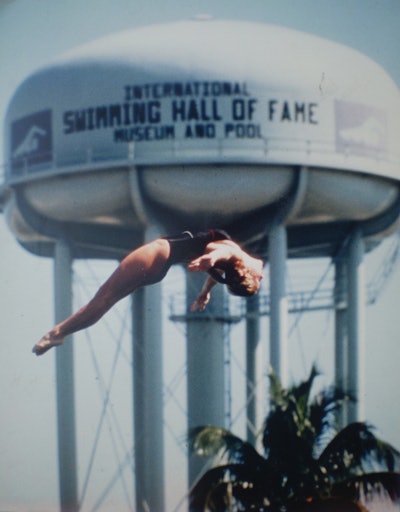Eds. note: For those of us who have followed pool water chemistry closely for decades, the evolutions of the technology are an endless fascination. When I first heard about this — AM frequency radio waves in pool water — it struck me as out of left field, which takes some doing because in this industry, we have a particularly deep left field. Like 400 feet. But on closer inspection, I raised my eyebrows in pleasant surprise.
It’s a proven technology that’s been around for years and has the stamp of NSF, IAPMO and ASHRAE on its research and testing. It sports enthusiastic testimonials from large commercial pools (as well as companies like Google and GM who use the technology to treat cooling-tower water with fewer chemicals).
It’s called “electronic floccing,” and it has already jumped into the commercial pool sector with both feet (the case studies quoted in this article are large public or competition pools), while as yet just dipping its toe into the residential sector. The company with the patent and the NSF sticker is Clear-Flow, a division of Flow-Tech Systems, out of Milwaukee.
Their residential unit is an easy-to- install device (about the size and shape of a baseball bat doughnut that just clamps around the pipe, no cutting involved). It draws about 5 watts, or about 5% of the energy of a 100-watt lightbulb.
It emits low-frequency, electro-magnetic waves in the AM radio range into the water to change the charge on particles and cause them to clump together, which leads to much better filtering, and thus better water quality. It doesn’t actually kill any pathogens or algae, but it makes the overall pool system work better, thus saving water and improving clarity, as anyone would expect of a 24-hour floc. As a secondary effect, it reduces chemical usage and chloramines, and impacts the development of biofilm.
WATER SAVINGS
Let’s start with the basics: Electronic floccing produces a dramatic drop in turbidity. One municipality that is utilizing the technology realized a 79% reduction of turbidity and saved more than 197,000 gallons by effectively extending backwashes of one of its pools from every two days to every 10 days.
That is one of the headline benefits, dramatic water savings on sand or D.E. filter cleaning (the company claims benefits to cartridge as well). It follows that if water savings are large enough, that is, if the amount of water lost to the pool when the backwash valve is flipped and pool water gushes out through the filter and into the sewer (or wherever), you start to see real savings in the constituents of that lost pool water — chemicals, heat and, of course, the precious water itself.
And the commercial pools that use electronic floccing have seen rather startling results in water savings because of sharp drops in backwash frequency and duration (see case studies).
Like any floc, electronic flocculation produces clumped particles large enough to collect on top of the media bed, but lab and field testing has shown that even as they build up, they continue to admit healthy flow. And thus, backwash cycles are impressively extended while flow rate and effective filtration are maintained.
In the words of Chris Hale, aquatic operation supervisor for City and County of Denver Parks and Recreation Department, a municipality that has embraced the technology, “Because a large portion of the particles settled on top of the filter sand and were not blocking or decreasing flow, we were able to go longer between backwashes.”
Under a water saving imperative, the technology allowed Denver to avoid more costly solutions.
“Wanting to continue to use sand filtration, electronic flocculation technology helps my organization with meeting environmental green targets. Additionally, and this is huge, there is no maintenance required for the system,” he adds.
UVT
Electronic floccing is of particular value to swimming pools using UV sanitization. UV works by running water past a UV lamp. The light from the lamp neutralizes algae and pathogens as the water passes. However, even a slight murkiness in the water absorbs the UV rays before they can kill their targets, and thus renders the system ineffective. As one would expect, a constant electronic floc that keeps water super clear works in tandem with UV to maximize its killing power.
The ability of water to transmit UV rays is measured as its UV transmission rate or UVT. Another municipality (not Denver) that is using electronic floccing saw UVT improve across three bodies of water to an average of 98% (see graphic).
Says Mark Meyer, co-founder, “We started putting equipment in the field with pool service providers on the commercial side that are dealing with pools that have low UVT rates. UV manufacturers know that they need to run it at least a 94% UVT in order for them to do what they’re claiming to do and do it at the rate that they’re claiming to do it at.
“Within six weeks, we brought UVT up sharply, in this particular case, working with a facility called CEM out in Colorado. It’s a brand new rec center that clearly had some water quality issues. It had three bodies of water with UVT rates as low as 71%. We brought all three pools up over that 94% threshold, as high as 99%. The win out of that was the operator was able to turn their UV back on because this particular facility had shut them down for over a year because what’s the point in running it if it’s not doing its job.”
CHLORINE AND CHLORAMINES
When it comes to sanitization parameters, Clear-Flow is still collecting data. At present, without the NSF stamp of approval on official lab measurements, the company makes no disinfection claims. But as anyone with experience in swimming pools would expect, if you’re floccing contaminants out of a pool at a higher rate than normal, you’ll see a drop in chlorine usage. And that has been borne out in field trials and testing by the International Association of Plumbing and Mechanical Officials (IAPMO), with results that include, on one pool, a 36% reduction of combined chlorine and a 27% reduction of makeup water.
“Operators will see these secondary or tertiary benefits — in addition to dropping levels of combined chloramines, they may see free chlorine start to rise. They may start to see improvements in ORP. We know that we help the filter catch organics very well, and if we’re doing that, we’re essentially minimizing the number of targets that the disinfectant is trying to go after,” says Kevin Brauer, director of business development at Clear-Flow. “Sanitization is not something that we lead with, but it is feedback that we’ve gotten from operators — it allows them to dial back their chemistry.”
“Truthfully, our go-to market strategy for the residential space is that even though we’ve done a few dozen residential pools, the biggest feedback that we get is chemical stability. People are virtually eliminating the need to shock. Obviously things happen — you can get a sudden high bather load at a party — but for the most part, they’re not seeing natural environmental issues causing the necessity of shock.”
STOPPING BIOFILM
In addition to chloramines, field test results from Clear-Flow installations have shown an impact on the development of biofilm in pools and spas. This is not surprising, as electronic floccing is used to treat cooling tower water with that same goal — inhibition of biofilm growth.
“At the University of Pittsburgh pool, one of the ASHRAE studies we did showed a 98% inhibition of biofilm compared to the control. That’s really what we do best — inhibit biofilm from ever taking hold. We would prefer to start with a clean slate,” Meyer says. “In one of our informal hot tub tests, where the owner was turning Clear-Flow on and off and watching the result, some of best feedback that we got was from the hot tub owner’s wife, who said she knew when he turned the clear flow unit off because she could see and feel the effect on biofilm in the hot tub.
Biofilm is able to fend off chlorine due to the slimy structure it builds around itself, but Meyer points out that the biofilm structure itself is over 90% water. “It’s extremely conductive, so we’re able to transmit our signal directly through it. So whether it’s in the cooling tower or a swimming pool, if there is a biofilm, the signal will penetrate and disrupt it.
NET EFFECT
My summary: Ours is an industry whose customers crave low-chlorine water care, which has led to the rise of such technologies as UV, ozone, AOP, etc. Electronic floccing offers another chemical-free weapon against the organisms which must be eliminated in order to swim safely.
It does so by improving filtration, not just of inorganic contaminants but organic ones, too. The system generates a low-frequency signal for consistent treatment, leveraging the water to transmit a safe and omnipresent signal, which flocs debris.
The net effect of the improved filtration, as shown by empirical research, includes:
- Reduced turbidity
- Increased stability of parameters
- Mitigated combined chlorine
- Water savings
- Extended filter life
- Lowered chemical usage


This article first appeared in the February 2025 issue of AQUA Magazine — the top resource for retailers, builders and service pros in the pool and spa industry. Subscriptions to the print magazine are free to all industry professionals. Click here to subscribe.






